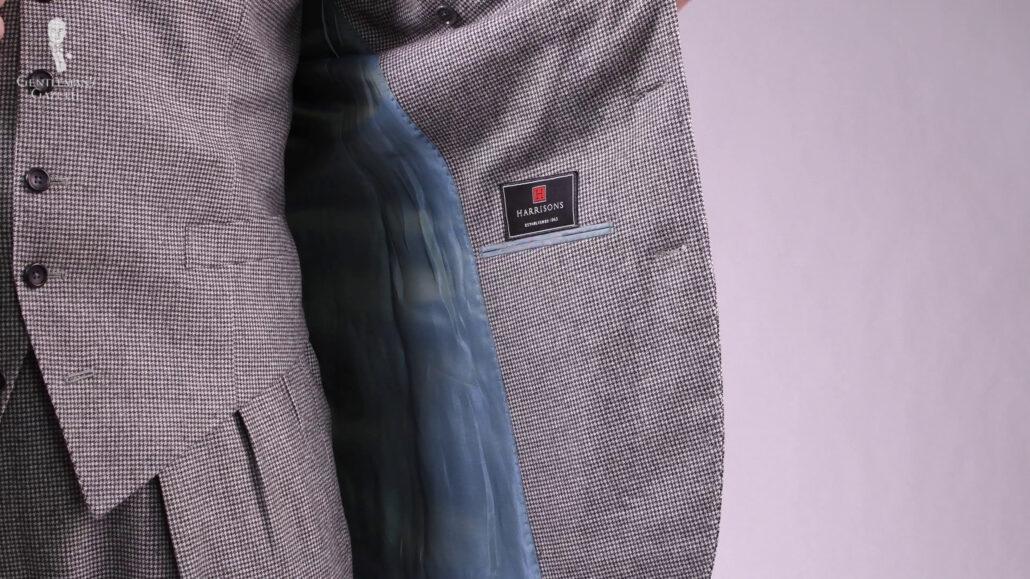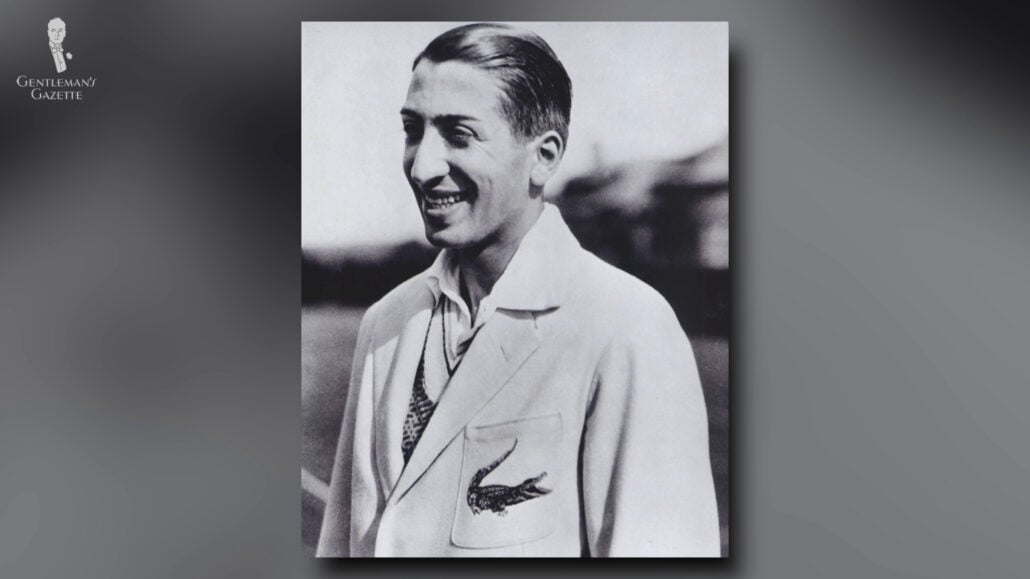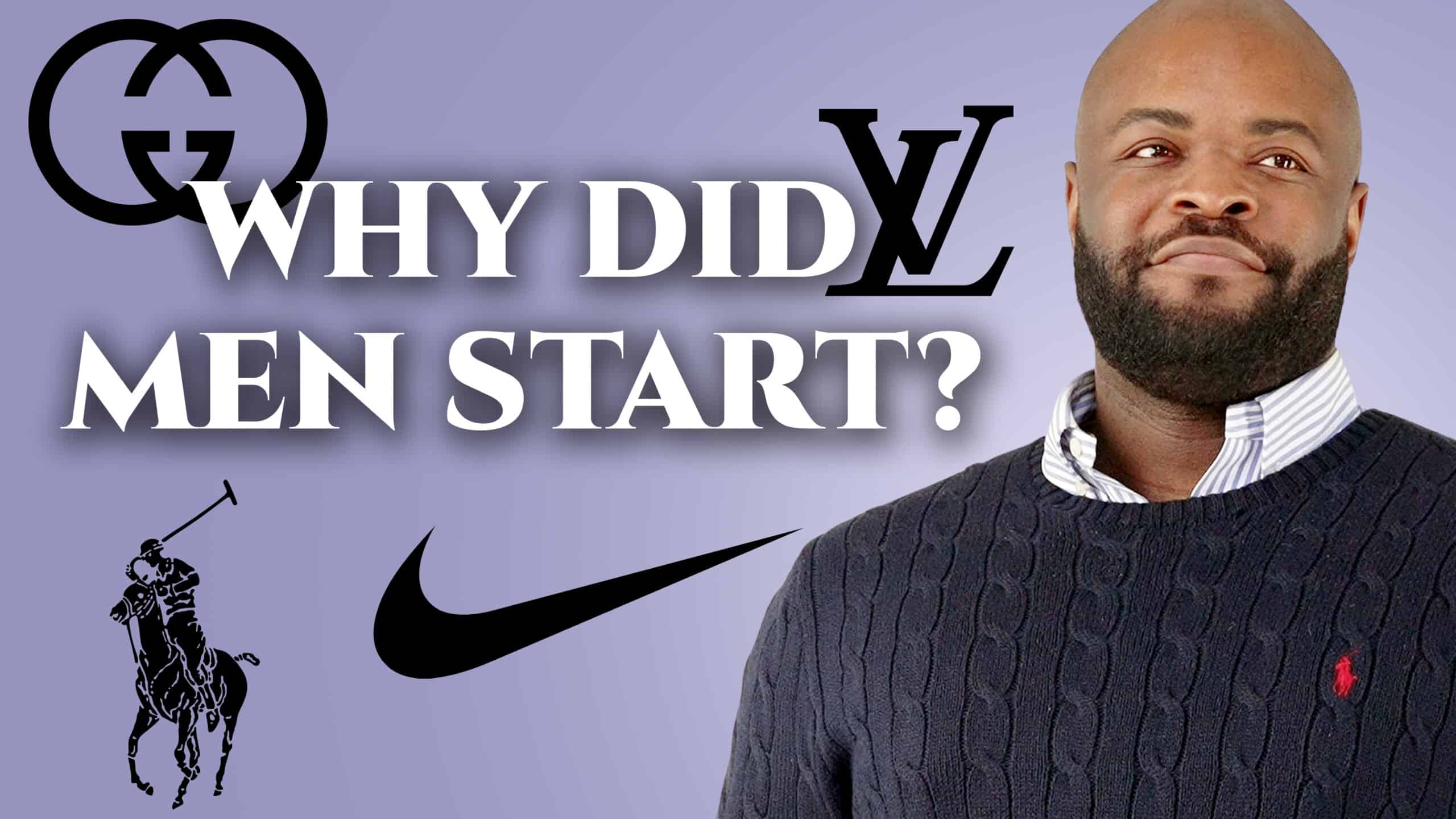Logos are regularly mentioned here at the Gentleman’s Gazette. In our Is It Worth It? series, we often take a look at how a little symbol or particular name can really up the price of a product. But, today, we will specifically tackle the question as to why men started wearing logos in the first place.
What’s in A Logo?
“Logo” comes from the Greek word “logos” meaning “word or speech.” In the early days of typesetting, “logotype” referred to a typeset block that contained an entire word or phrase rather than individual letters because companies used logotypes to stamp their identifying markers on the products.

“Logo” came to mean any graphic mark, emblem, or symbol used to aid and promote public identification and recognition. Logos are essential to modern branding. As graphic designer Milton Glaser observed, “the logo is the point of entry to the brand.” Logos can include names – often in a distinctive font – initials, dates, symbols, and images. Many are so iconic, even the font can put you in mind of the associated product.
Oftentimes, companies associate elements of their logo onto their product like the Adidas 3-stripe detailing or the Hermes “H” divorced from the full Hermes logo. But, a logo in the sense of a distinct brand identifier can be even more subtle. The Burberry tartan is regularly used to identify Burberry products, or the unique cadmium green of the Rolex logo that sometimes appears on the watches themselves. So, to some extent, a logo can be any marker that identifies who made a particular product.

Nowadays, in addition to being found on individual products, logos have made their way onto accessories or attendant items like an Allen Edmonds branded shoe shine brush or a Giorgio Armani garment bag. And that’s just covering menswear companies.
Plenty of other types of logos can be found on menswear that identifies musical groups, brands, and even our favorite fictional superheroes.
Logos in History
Prominent logos are a common feature of men’s fashion today, and while this trend developed relatively recently, its origins can be traced back further than you might have thought. Symbols developed before written language and have even been used throughout history to identify spiritual, significant locations, political institutions, religious beliefs, factions, and armies.

Symbols on flags and uniforms may have been vitally important to be able to distinguish friend from foe. But, in some cultures, it became a form of personal advertising. Medieval heraldry allowed knights to be easily identified, so that their deeds could be associated with their own honor and the honor of their families. Other means of personal wearable identification like initials were also popular like signet rings, robes, and smoking jackets.
To jump a little bit forward in history here, the most common form of the wearable identifier in the modern West came in the form of crests and colors or, effectively, logos of prominent schools and universities. School colors were emblazoned on garments like rowing blazers and crests featured prominently on school uniforms. While school symbols can be found regularly on athletic wear like the uniforms of the 1888 Yale football team.

This style of dress would heavily influence the development of the Ivy and prep style of the early-20th century. These scholastic emblems could be considered the first logos to appear on menswear in the 20th century, but they would not be the last.
The Evolution of Maker’s Marks
Meanwhile, the ancient custom of craftsmen signing their products with a maker’s mark – done to identify who made it – evolved during the Industrial Revolution into a more standardized form; into what we now recognize as a trademarked logo. That indicated quality assurance, legitimacy, and brand recognition. Effectively, the logo helped identify the maker of the product while assuring the potential buyer that it was genuine and quality-made.

In menswear, these logos were discreetly hidden as tags or labels on the inner lining, and you’ll find that this is still the custom of many tailors on the famous Savile Row today. But, some manufacturers use their logos in more creative ways. Famously starting in the late-19th century, Louis Vuitton trunks were marked with the mark Louis Vuitton to deter counterfeiting and to provide free Louis Vuitton advertising at every fashionable railroad station, cruise ship dock, and hotel where the trunks were carried.
In clothing, however, logos remained less prominent until an intersection between corporate branding and our previous topic of school logos. In the early-20th century, schools, colleges, and universities underwent a considered effort to build and standardize athletic programs. In addition to uniforms for athletes, companies also created logoed clothing for students to express their school pride.

The Knickerbocker Knitting Co., later rebranded as “Champion”, was commissioned by the University of Michigan in 1934 to create one of the first lines of collegiate wear; from socks to hoodies, all in the University of Michigan maize and blue.
At the same time, the increasing popularity of professional sports saw fans dressing like their sports heroes, like tennis fans and René Lacoste’s famous polo tennis shirt with its iconic crocodile, which became one of the first menswear logos prominently displayed on a garment. Polos and tennis shirts had a long history of displaying crests of schools, clubs, and teams, so the Lacoste crocodile was in good company.

Sportswear and Logos
Starting after World war II, the general sports world saw another shift regarding logos and how logos were depicted on sportswear. Like most menswear, other sportswear maker logos, other than the Lacoste crocodile, were discreet early on.
But, because athletic wear was a functional and also decorative garment, manufacturers realized the utility of advertising their products while they were effectively being demonstrated by the athletes wearing them. For instance, athletic shoes were marked with a unique design detail called a “stripe” that identified the maker.

This stripe could be anything. The Adidas stripes are a stripe, but the Nike “swoosh” was also a stripe. Like Louis Vuitton, sportswear makers recognized how important it was for famous people – and in this case, athletes – to be seen wearing their products.
Graphic Tees and Logos
Around the same time, other institutions were also recognizing the value of free advertising by having their supporters wear their logos on clothing. And this cheap and effective advertising was achieved through the printing of graphic T-shirts. Although this has been around since the 1930s, it became less expensive with printing innovations that arrived in the 1960s.
These T-shirts were often souvenirs and commemorated musical events, historic sites, major anniversaries, and the “Happiest Place on Earth.” Graphic tees were often seen as an opportunity for self-expression and creativity at a time when these qualities were much more ascendant in menswear. But, they also gave consumers the chance to acknowledge their favorite products, and manufacturers were happy to enjoy the free advertising.

These graphic tees, along with sportswear, slowly found their way into the regular clothing wear rotation; normalizing wearing brands and contributing to the overall casualization of menswear. While graphic tees provided an affordable way to express company loyalty, logos were soon employed to express wealth, menswear has always afforded opportunities for ostentation.
For most of the 20th century, though, these displays did not rely explicitly on brand recognition, but instead on the use of expensive materials, fashionable cuts and patterns, or bespoke detailing like Barchetta pockets or custom lining.
Conspicuous Consumption and Logos
Starting in the late 1970s and coming to ascendancy in the 80s and 90s, rap and hip-hop introduced a new form of conspicuous consumption that explicitly named brands. Rapping hip-hop artists often crafted narratives of their hard-fought ascendancy from a life of poverty to a life of ease and excess. And such lives were fostered with items from luxury brands like Cadillac cars, Hennessy brandy, and blinged-out everything. And, of course, menswear featured prominently.
In 2014, PicClick helmed an exhaustive study of brands explicitly mentioned in rap and hip-hop lyrics. They found that Gucci was overwhelmingly mentioned the most; coming in at almost twice as many references as second place, Nike. Other famous menswear brands mentioned include Prada, Versace, Giorgio Armani, Louis Vuitton, Valentino, Calvin Klein, Burberry, Hermes, Gaultier, and Lacoste. And not surprisingly, many of these brands have partnered with famous rappers. I guess Gucci and Gucci Mane would be a great match.
This trend in music was following an existing trend in advertising from the 80s and 90s, in which companies were more explicitly trumpeting the value of their brand, in addition to the value of their products.

The 80s is considered the first “designer decade” as parodied in the novel and the movie American Psycho, in which there’s an enormous emphasis on the brands worn by the characters. Throughout the 80s and 90s, sportswear and sportswear-adjacent articles of clothing, like polo shirts, for example, were prone to heavy branding. Not coincidentally, the prep style, with its roots in the crested blazer halls of Eden and Harvard, was closely associated with the logo polo craze.
The 2000s saw “logo-mania” hit high fashion with the design houses like Versace, Gucci, and Louis Vuitton leaning heavily on designs that featured the prominent logos. The original “designer decades” were attacked for promoting inequality and globalization, most notably by Naomi Klein, in her 1999 book No Logo: Taking Aim at the Brand Bullies.
However, the “hype culture” of the late 2010s and early 2020s seemed to indicate that there is still considerable interest in brands and brand display today, as companies offer new product lines, unusual collaborations, and innovative marketing that always promises to be the next big thing, all wrapped up in logos.
Why Men Wear Logos
So, having traced this history, what can we conclude about men wearing logos? We’ve condensed our findings into three broad concepts.
1. Logos Promote Community
The earliest logos worn in menswear were associated with groups like schools, clubs, and sport teams. They created a feeling of unity when like-minded people were gathered together like an entire stadium of black-and-orange-clad fans cheering, “Go, Princeton, go!”.

It builds a connection between people who might have nothing else in common, like when two strangers wearing maroon, blue, and yellow greet each other and say, “Come on, you Irons!”
The positive feelings associated with these kinds of encounters may have encouraged the wearing of athletic wear outside of sports venues; to better foster a sense of togetherness elsewhere.
2. Logos Represent Cachet Throughout Brands
Of course, logos are primarily intended to represent specific brands. And while maker’s marks were originally intended to guarantee quality and authenticity, when those logos are put front and center, it’s clear they’re meant to advertise the brand. This concept captures the modern function of logoed wearables as conspicuous consumption.
We want to be clear, logoed clothing is not the first time men have used clothing to express wealth and influence. That first occurred about a million years ago when one caveman made fun of another for still wearing mammoth skins when mylodons were all the rage.

But logoed wearables have made a new form of conspicuous consumption as the social value of clothing is not dictated by being made from expensive materials or artisanal craftsmen, but by the presence of a particular name.
In an age of increasingly casual clothing, some men prefer displaying their wealth in the form of a $770 T-shirt or a heavily-logoed $7,850 shearling crewneck. That costs the same as an entire custom suit. In an age of casual clothing where it seems like everyone is wearing T-shirts and sweatpants, logos are the easiest way to stand out and convey your wealth.
3. Logos Convey Ideals
We don’t want you to think that logos are inherently bad things, though. During the graphic tee craze of the 60s and 70s, shirts featured things that people simply liked; many of which happened to be logos of corporations, bands, or places. The fact that these logos were associated with businesses or companies wasn’t necessarily their main appeal. But, instead, it was the idea behind the logo like never losing your childlike whimsy or being the hero of your own story.

This same logic can also apply to menswear logos. Sometimes the ethos behind a brand can have great personal appeal, like Nike’s push for personal excellence in sports and life. Conversely, others might like the story behind the brand like the fascinating personal story of René Lacoste, who’s so closely associated with the brand that bears his name.

Also, wearing recognizable brands give some men confidence as though wearing the logo bestowed the flash of Versace, the glamor of Gucci, or whatever the Simpsons-Balenciaga collaboration is trying to convey.
Wearing brands doesn’t have to be about showing off. It can be about showing something about yourself.
Conclusion
So, now that we know a little bit more about why men started wearing logos, we hope that you better understand their place in modern menswear, because logos don’t have a prominent place in classic style.


You’re not going to see many of our looks incorporating them, but we do appreciate that some men like logos and that’s okay. It doesn’t mean that they’re just walking billboards. In fact, did you know that when Raphael first met his wife Teresa, he was wearing a Big Pony polo shirt? I wonder whether his collar popped or not.
Outfit Rundown
Today, I’m wearing a Ralph Lauren cable knit, blue sweater, a Ralph Lauren blue and white, long-sleeved sport shirt, along with green chino pants and brown dress shoes. I’m finishing off the outfit with some brown Fort Belvedere socks. Check out the Fort Belvedere shop for socks like these.
Would you wear logos today? If so, what types? Let us know in the comments!




I live in a country where knock-offs of clothing items and bags bearing the logos of every luxury brand you can think of are readily available–and sold by street vendors to two groups of people–the underprivileged and tourists (usually American).
Consequently, (ironically?) wearing a distinctly-branded t-shirt, for example, may be a sign of poverty, while people with money and good taste tend to avoid items bearing logos. Also, for example, polo shirts with no logo whatsoever tend to be better made, use high-quality materials, and are more expensive.
I suspect that this may be true in many parts of the world.
It’s so nice to read a GG article that isn’t ridden with grammatical and syntactical errors.
They started because that’s how the New Testament started.
“In the beginning was the word” which in the Greek used for “word” in the New Testamant was “logos.”
Now, Sven, how many of your regular comment makers can offer up biblical wiseass observations? (Probably it is fortunate that there aren’t many. :-] )
Visible logos on garments or accessories are gauche and should be avoided. Sometimes they cannot be avoided, e.g., on athletic shoes. T-shirts or sweatshirts with large logos are in poor taste. Any exception might be college names or logos, but only if you attended the school (or perhaps sent your kids (and your tuition dollars) there.
The height of absurdity is when people spend lots of money to buy garments with visible logos; they are in effect paying the clothing company to advertise its products. If you want space on my chest or head (think baseball cap) to promote your company, at least give me the shirt or hat for free. Even then, wearing it speaks of insecurity and a desire to present oneself to the world as someone one is not.
exactly my thoughts!
Mine too.
Syntax is a part of grammar, the overarching rules dictating the structure of a language. All syntax rules are grammar rules, but not all grammar rules are syntax rules.
Mine too.
Why the Man wear Logos, we want to be sexy!
I think it is a everyday Luxury, to feel better.
The use (or misuse) of logos — or more accurately trademarks — dates further back. In the late 1970s and early ’80s, Pierre Cardin’s “PC” monogram was everywhere, licensed for all sorts of goods, the quality of which was dubious if not downright poor. Still they were marketed as “designer” labelled. More recently such brands as Nautica and Polo Ralph Lauren have increased the size of their trademarks on garments to pander to the status- obsessed nouveau middle class in Asian markets. Many once-respectable European brands are now owned by the LMVH conglomerate which exploits their historical goodwill for the vulgar & ruthless pursuit of profit. Gentlemen aren’t billboards for brands. Logos are for pretenders.
Kyle, you look very classy in your ensemble.
In my opinion, I feel that flashy logos are overrated and in today’s society, I feel it is not much of a wealth symbol, but more of an insecurity status. When the new”it” label comes into “all the rage, trendy”, I just sit back and watch the carnage. It’s actually kind of sad to watch society think that will make them somehow be somebody. I would love to see the day when everyone dressed decent and not be so materialistic. Just be comfortable with yourself.
Looking at the Fort Belvedere socks in the outfit rundown, I find it pleasing to note the logos are on the bottom of the foot. I remember seeing colleagues at work wearing classy suits…with Oroton socks – I knew that much because the Oroton logo was placed quite prominently on the calf and in fluro green.